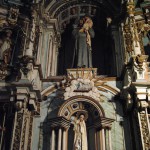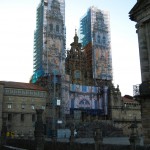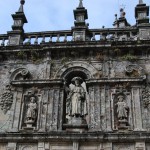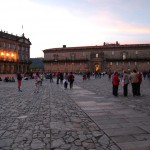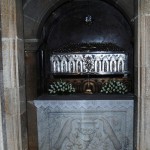Cathedral in Santiago de Compostela (Spain)
Located in the north-west of Spain, literally on the earth’s end (this is how the ancient Romans called this place – «Finis Terrae», “the earth’s end”), the city of Santiago de Compostela is reckoned to be the third most important city of the Christian world after Jerusalem and Rome; and it is still the object of mass pilgrimages. It is called “the Christian Mecca.” Here, in Santiago de Compostela, there is the greatest relic of Spain – the remains of Saint James, the heavenly patron of the country.
The very name of the city – Santiago – is related to the name of Saint James (in Spanish – Sant Yago). Apostle James the Greater – “Son of Thunder”, as he is called in Spain, just like his brother, Apostle John, was a simple fisherman and one of the first disciples of Christ. They say that when the twelve apostles went to all the corners of the earth to announce the Glad Tidings, James went to preach the gospel to Spain. At that time, it was a remote Roman province. After he travelled on the roads of Spain and raised up the first Christian communities here, James returned to Palestine. There he was captured at the order of King Agrippa and beheaded in 44 C.E. The disciples of Saint James put his body in a boat and sent it upon the waves of the Mediterranean Sea.
This boat in a miraculous way was cast upon the Spanish seashore at the mouth of the Ulla River, on the spot, where the city Santiago de Compostela is located now. In 813, a hermit monk named Pelagius, who lived here, saw a guiding star, which led him to the ark with the remains of saint James. Although eight centuries had passed by, the body had not yet been touched by corruption. In 896-899, according to the order of King Alfonso III, on the spot of the discovery, a little church was erected over the ark, and this place was called Compostela – from Latin Campus Stellae – “Field of the Star.”
The invention of the relics of Saint James happened at the extremely difficult and dangerous times for Spain: the Moors conquered almost the entire Iberian peninsula, and only a tiny piece of land in the Mountains of Asturias remained in the hands of the Christians. And the manifestation of Saint James’ relics was perceived by the Spanish as a divine sign from above. Indeed, from that time the progress of the Moors’ Conquest was reversed, and the Reconquista began. As the result, the Arabs were driven out of the Iberian Peninsula, and Saint James became the Spain’s heavenly patron in people’s minds. The old chronicles narrate, that during the battles with the Moors, Saint James was seen on many occasions in the form of a White Knight, who waged his sword with a battle cry: «Santiago y cierra España!» to put the numerous crowds of Arabs to flight. This is how the Spanish sculptors portrayed Saint James in the Middle Ages most often: on horseback, striking the Moors.
From the day when the relics of Saint James were invented, Compostela became an especially venerated holy site in Spain. This tradition, supposedly, was established by Emperor Charlemagne. The Pope of Rome Callixtus II granted Santiago de Compostela the privilege for issuing the indulgence (complete forgiveness of sins), thus equalling this city to Rome and Jerusalem. An unending flow of pilgrims streamed to it from France, Portugal, Italy, Poland, Ireland, England, and other European countries. The route from Europe to the Iberian Peninsula, which was walked by the worshippers, who were making their way to the Holy city on foot, received the name The Way of Saint James. Its main route starts in the south of France, goes through the Pyrenees, past the Spanish cities of Logroño, Santo Domingo de la Calzada, Belorado, Burgos, León, Astorga, Ponferrada, and Vilafranca del Bierzo, leading to Santiago de Compostela. Now the Way of Saint James with its entire route is declared the World Heritage Site under the protection of UNESCO.
Saint James of Compostela, who made the first long journey to Spain, was revered as the pilgrims’ patron. In Medieval art he is depicted either as a traveller wearing a hat decorated with scallops, with a staff and a bag, or as an Apostle in a tunic and with a scroll in his hand, surrounded by believers. Like the Magi in the Gospels, who were led by a guiding star, the pilgrims on their way to Compostela learned their direction at night from the Milky Way, which in Spain is called the Way of Saint James. According to the local tradition, the saint drew it in the sky to show Charlemagne the way to go in his campaign against the Saracens.
An amazing natural, cultural and historical landscape, through which the Way of Saint James runs, has been preserved till our days virtually intact — with its arched bridges, spanning the mountainous springs, worship crosses, pilgrim churches and chapels, castles and fortresses, hotels and inns, old villages and towns, through the streets of which the pilgrims with their staffs are deliberately walking, heading for Compostela.
The panorama of the city, unfolding before the traveller’s eyes, captures him at one instant, making him forget the weariness and the hardships of the journey he passed. The old Compostela is one of the most beautiful ensembles of Europe, which has been preserved until this day. Santiago de Compostela is called “the city of a hundred towers,” “the lighthouse of the Christian world.” And above its numerous towers and spires, the golden domes of the magically beautiful Cathedral of Saint James dazzle and shine.
The first temple at the tomb of Apostle James was built by king Alfonso II and bishop Theodomirus in 829. King Alfonso III the Great, at the end of the 9th century, replaced it with a basilica, which was more beautiful and significant in size, but in 997, the Moors under al-Mansur destroyed the church during one of their raids.
In 1078, under the French monastic architect Bernard from Cluny, the construction of the new cathedral began. It had a number of stages (1077/78 — 1088; 1100 — 1128), and lasted for several centuries. By 1521, the cathedral was mostly finished.
The cathedral in Santiago de Compostela is the most important structure of Medieval Spain. Its interior has kept its Romanesque character, although the reconstructions of the XVIIth—XVIIIth centuries significantly changed the appearance of the temple. In 1676—1680s, the Clock Tower was built (architect Domingo de Andrade), and in 1738—1750s, architect Fernando de Casas Novoa completely refashioned the main facade of the cathedral — it bears the name Facade of the Obradoiro — and of the 75-meter tower, giving them the features of the pompous and magnificent Baroque style of that time in its Spanish variant — the Churrigueresque. The north facade, known as da Acibecharía (finished in 1770), is the work of architect Lois Monteagudo.
In the centre of the west facade, in a deep niche, there is a statue of Saint James. The portals, framing the entrances to the cathedral, are richly decorated with sculptures of the XIth—XVIth centuries. The oldest reliefs can be seen on the south gates — Puerta de las Pratarias. But the most significant monuments of art decorate the portico of Glory — Pórtico da Gloria, on the west facade, which engraver Master Mateo was creating for over twenty years (1168—1188). This is the highest peak of the Romanesque plastic art in Spain. Master Mateo, obviously, must have been very well acquainted with the sculptural portals in Burgundy and Île-de-France.
The portico is topped with a large sculptural image of God the Father, holding His crucified Son in His lap, whom He sent into the world for the sake of His love for people. On a column, at the height of a raised hand, there are five indentations – they are believed to be the imprints left by the hand of Jesus Christ. There is a belief, according to which, the grace of the Holy Spirit will descend upon the pilgrim, who would put his fingers into these imprints.
The main gates of the Cathedral – the Holy Gates (Puerta Santa) are opened only in the “Holy Year,” that is, the year, when July the 25th, the day of commemoration of Saint James, falls on the Lord’s Day. When one enters the temple, he is amazed at its huge size. The cathedral is built in the shape of a Latin Cross; its length is 97 meters, the height of the central nave is 24 meters. The semi-darkness inside the cathedral, makes its atmosphere somewhat mysterious, anticipating the pilgrim’s meeting with the main relic – the tomb of Saint James. It is located in the basement floor of the cathedral – in a crypt. The sarcophagus is made out of silver and has a rather later provenance.
There is a museum functioning in the cathedral, with a rich collection of Spanish art of the IXth—XIXth centuries, including the tapestries, executed according to the sketches by Rubens, Goya, and other great masters.
There are always a lot of people in the cathedral and around it. For over a thousand years of its existence, millions of pilgrims have visited it, including many world celebrities – from Saint Francis of Assisi and Pope John Paul II to the writer Paulo Coelho and Hollywood star Shirley MacLaine. Besides the main, French way, there are several other routes leading to Santiago de Compostela: the Coastal Way, stretching from the Pyrenees along the coast, through the land of the Basques and through Asturias; the Eastern Way, leading from Seville through Merida and Salamanca; the English Way — it was used by the pilgrims from England and Ireland, who came ashore at the Spanish port La Coruña to come to Compostela; the Portuguese Way, which has its beginning in Portugal’s capital, Lisbon. Crossing the Iberian Peninsula on all sides, these roads are drawn to one spot — to Santiago de Compostela, where several million people come in our days, both pilgrims and tourists, attracted by the numerous historic monuments of the city. For a good reason the old Spanish saying states, “All roads lead to Compostela.”
This article has been translated from the book “The World’s Greatest Temples” by A. Y. Nizovsky – Moscow; Vetche; 2006. – 576 pages.

